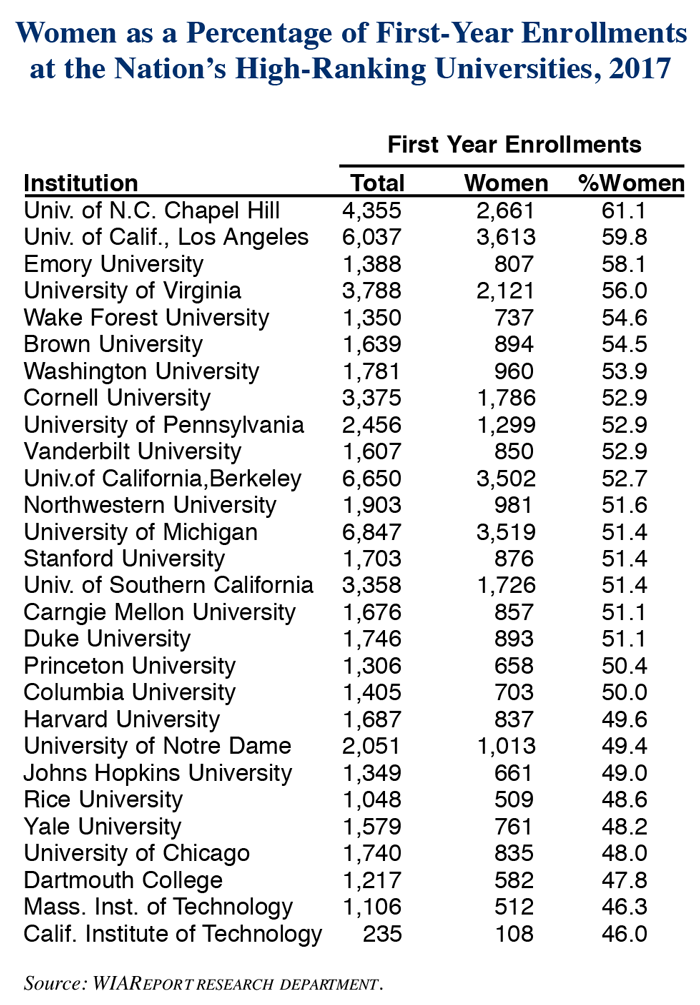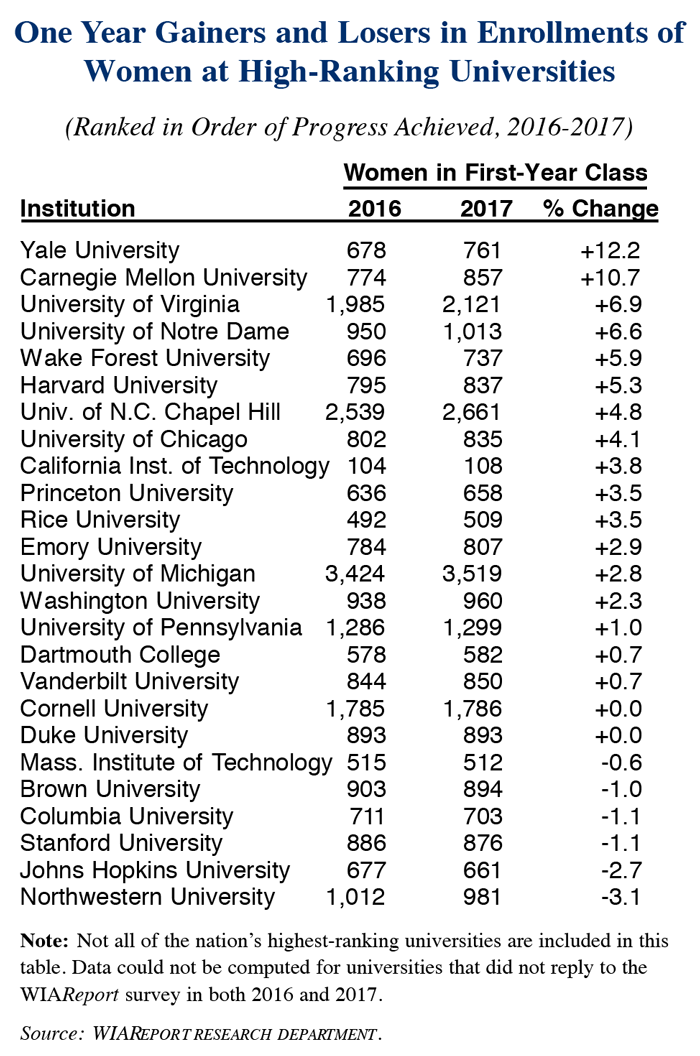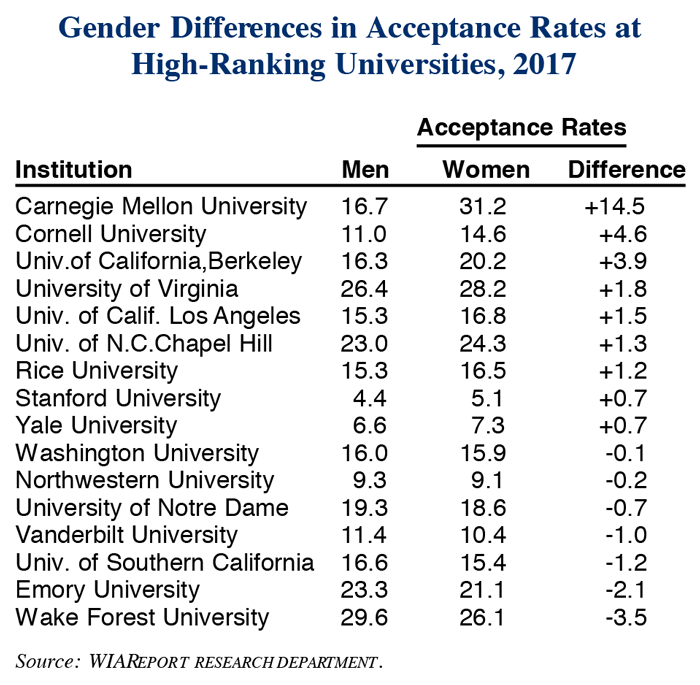First-Year Women Students at the Nation’s Leading Research Universities
Posted on Mar 13, 2018 | Comments 0
![]() For the seventh year in a row, WIAReport has surveyed the nation’s highest-ranking research universities to determine the percentage of women in this year’s entering classes. We also report on gender differences in acceptance rates at these schools and whether women have made gains in enrollments at these universities compared to where they were a year ago.
For the seventh year in a row, WIAReport has surveyed the nation’s highest-ranking research universities to determine the percentage of women in this year’s entering classes. We also report on gender differences in acceptance rates at these schools and whether women have made gains in enrollments at these universities compared to where they were a year ago.
Of the 28 high-ranking universities for which we have data, women were a majority of the entering students at 19 schools. Two years ago, women were a majority of the first-year students at only 11 high-ranking universities.
There are wide variations in the percentage of women in the first-year classes at these highly rated universities. For the seventh year in a row, the highest percentage of women in the entering class among this large group of leading research universities is found at the University of North Carolina at Chapel Hill. There are 2,661 women among the 4,355 entering students at UNC this year. Thus, women make up 61.1 percent of all first-year students, up slightly from a year ago.
The University of California, Los Angeles has an entering class that is nearly 60 percent women. This places UCLA in second place in our survey
For four of the past five years, Emory University in Atlanta had the second-highest percentage of women in its entering class among this group of leading research universities. This year, women make up 58.1 percent of the entering class, placing Emory third in our survey.
The University of Virginia is in fourth place, the same position it held last year. Women are 56 percent of the first-year class at the University of Virginia, up from 53.8 percent a year ago. At Washington University, Brown University, and Wake Forest University, women make up more than 53 percent of the entering students. Women are more than 52 percent of the entering classes at Cornell University, the University of Pennsylvania, Vanderbilt University and the University of California, Berkeley
At the other extreme, the California Institute of Technology has an entering class where women are 46 percent of all first-year students. This is the lowest percentage among high-ranking universities in our survey group. However, this year’s percentage of women in the entering class ties a record at Caltech. And there has been significant progress at CalTech in recent years. Four years ago, women made up only 35 percent of the entering class.
At the Massachusetts Institute of Technology women are 46.3 percent of the first-year class. This is the second lowest percentage among the major high-ranking research universities. It is hardly surprising that these universities have the lowest percentage of women in their entering classes considering that these schools have large numbers of students in engineering and other STEM disciplines where historically women have been vastly underrepresented.
Two years ago, Carnegie Mellon University in Pittsburgh had an entering class where women made up 45.9 percent of all first-year students. This was the lowest percentage in our survey that year. Like MIT and CalTech, Carnegie Mellon too, has a large number of students in engineering and STEM disciplines. But this year, women are a majority of the entering class.
At Princeton University in New Jersey, there are 658 women in the first year class and 648 men. This is the first time in the history of Princeton University that women have outnumbered men in an entering class.
We can compare last year’s results to the current data to see where women are making progress. Of the 25 leading research universities for which we have data in both years, 18 schools show an increase in the number of women first-year students and only six show a decline. At Duke University, there is the same number of women in the entering class this year as was the case a year ago. It must be noted that an increase in the number of women in the first-year class may not reflect a fluctuation in the gender ratio but may simply result from more students overall in the first-year class.
The number of women in the first-year class at Yale University is up 12.2 percent from 2016. This is the largest percentage increase in our survey. But this was due to a 15 percent increase in the number of students in the entering class. The percentage of women in the entering class at Yale is actually less than was the case a year ago.
Carnegie Mellon University was the only other leading research university to post a double-digit increase in the number of women in its entering class. The University of Virginia, the University of Notre Dame, Wake Forest university and Harvard University, all had at least a 5 percent increase in the number of women in the first-year class.
Johns Hopkins University and Northwestern University were the only two leading research universities that had a drop of more than 2 percent in the number of women in their entering classes.
It is well known that nationwide women outpace men in college enrollments, graduation rates, and degrees earned. Because of a large and growing gender gap in enrollments at many colleges and universities, it has become easier for men to gain admission to some colleges and universities. It must be noted that just because men have a higher acceptance rate than women at a given institution does not necessarily mean that men have received an unfair admissions advantage. A particular college or university may simply have had an outstanding pool of male applicants in a given year.
We do note that many high-ranking universities are reluctant to report gender differences in acceptance rates. This year, only 16 chose to do so. We will simply present the data and let readers make their own conclusions.
Of the 16 highly rated research universities that supplied data, we find that women were accepted at a higher rate than men at nine institutions. Men were accepted at a higher rate than women at seven institutions. Most of the differences are very small and should not be considered significant
The greatest difference was at Carnegie Mellon University, which as stated is heavily focused on STEM disciplines. At this highly rated university, 31.2 percent of women were accepted for admission compared to only 16.7 percent of male applicants. Thus, there was a very large acceptance rate gap in favor of women of 14.5 percentage points. The gender gap increased from 13.3 percentage points last year to 14.5 percentage points this year.
The next highest acceptance rate gap in favor of women was 4.6 percentage points at Cornell University. The only other leading research university where the accepted rate for women was two percentage points higher than the rate for men was the The University of California, Berkeley.
At the other end of the spectrum, Wake Forest University in Winston-Salem, North Carolina, had the highest gender gap in acceptance rates in favor of men. At Wake Forest, 29.6 percent of male applicants were accepted compared to 26.1 percent of women applicants. However, the gender gap in favor of men dropped from 7.6 percentage points last year to 3.5 percentage points this year.
Emory University in Atlanta was the only other high-ranking research university where men were accepted at a rate at least two percentage points higher than women.
Filed Under: Featured











